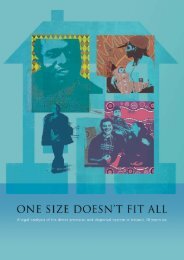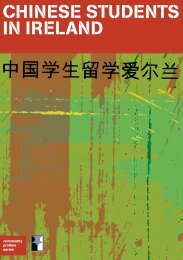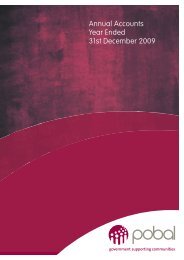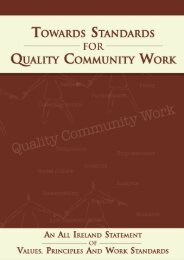Intercultural Education in the Post-Primary School - National Council ...
Intercultural Education in the Post-Primary School - National Council ...
Intercultural Education in the Post-Primary School - National Council ...
Create successful ePaper yourself
Turn your PDF publications into a flip-book with our unique Google optimized e-Paper software.
PLANNING THE PHYSICAL ENVIRONMENT OFTHE CLASSROOMThe messages that are communicatedthrough <strong>the</strong> physical environment of <strong>the</strong>school and classroom are important. Theyare often <strong>the</strong> first messages that parentsand pupils receive <strong>in</strong> a school, and <strong>the</strong>yrema<strong>in</strong> as a constant rem<strong>in</strong>der of <strong>the</strong>person’s place <strong>in</strong> <strong>the</strong> school. <strong>Intercultural</strong>classrooms are characterised by learn<strong>in</strong>genvironments that reflect and show pride<strong>in</strong> <strong>the</strong> language, ethnic and culturaldiversity that characterises Ireland. Theyshould provide a support for <strong>the</strong> positiveself-image of all students, irrespective of<strong>the</strong>ir ethnicity, as well as re<strong>in</strong>forc<strong>in</strong>g <strong>the</strong>normality of diversity for all children.Some of <strong>the</strong> key issues <strong>in</strong>volved <strong>in</strong>plann<strong>in</strong>g <strong>the</strong> physical environment of <strong>the</strong>classroom are• represent<strong>in</strong>g diversity as a normal partof Irish life and human existence• ensur<strong>in</strong>g that representations of m<strong>in</strong>oritygroups do not focus on ‘spectacular’ or‘colourful’ events• ensur<strong>in</strong>g that all students irrespective of<strong>the</strong>ir colour, religion, ethnic group, orability can feel at home and representedwith<strong>in</strong> <strong>the</strong> classroom.Some areas for attention <strong>in</strong>clude• classroom displays• textbooks and o<strong>the</strong>r resource materials• classroom behaviour and structures.Classroom displays should representdiversity <strong>in</strong> Ireland <strong>in</strong> a positive way.• Images displayed might <strong>in</strong>cluderepresentations of people from diverseethnic and cultural backgrounds.Sufficient images from m<strong>in</strong>ority ethnicgroups should be used to ensure that <strong>the</strong>dom<strong>in</strong>ance of <strong>the</strong> majority ethnic group<strong>in</strong> images of Ireland <strong>in</strong> everyday life isbalanced. Care should be taken toensure that <strong>the</strong>re are also balancedrepresentations of different age, gender,and social class and ability groups.• The images should be chosen to reflectaccurately people’s current daily lives <strong>in</strong>Ireland, ra<strong>the</strong>r than focus<strong>in</strong>g solely oncolourful events like feasts or festivals orover-rely<strong>in</strong>g on images from o<strong>the</strong>rcountries. This will help to overcomestereotypes.• Class displays might represent positiverole models drawn from <strong>the</strong> diverseethnic, cultural, gender, social class andability groups that make up Ireland.• Artwork and cultural displays, <strong>in</strong>clud<strong>in</strong>g<strong>the</strong> students’ own work, should bedrawn from a range of culturaltraditions.• Writ<strong>in</strong>g signs and notices <strong>in</strong> both Irishand English has long been commonpractice <strong>in</strong> many Irish schools.Expand<strong>in</strong>g this practice to recognise <strong>the</strong>o<strong>the</strong>r languages of <strong>the</strong> school <strong>in</strong> this waywill be of value.• Signs, notices and announcementsshould reflect and affirm <strong>the</strong> languagediversity of <strong>the</strong> class and should support<strong>the</strong> needs of second language learners.As such, notices may be <strong>in</strong> a range oflanguages (Irish, English and, asappropriate, Cant/Gammon,Bosnian/Croatian/Serbian or Yoruba,for example).Choos<strong>in</strong>g textbook and o<strong>the</strong>rresource materialsThe <strong>in</strong>fluence of textbooks on studentattitudes is well documented. It has beenfound that <strong>the</strong> words and pictures not onlyexpress ideas-<strong>the</strong>y are part of <strong>the</strong>educational experience that shapes ideas.For example, how members of m<strong>in</strong>oritygroups or women are treated <strong>in</strong> textbooks<strong>in</strong>fluences student attitudes and values.Favourable stories engender more positive38<strong>Intercultural</strong> <strong>Education</strong> <strong>in</strong> <strong>the</strong> <strong>Post</strong>-<strong>Primary</strong> <strong>School</strong>
















